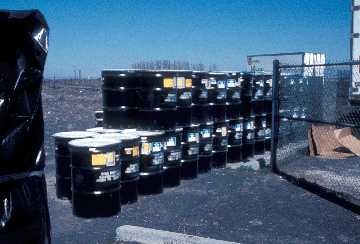The Resource Conservation and Recovery Act (RCRA) governs the management and disposal of hazardous wastes, including pesticides.
To be considered hazardous waste, a material first must be classified as solid waste. The Environmental Protection Agency (EPA) defines solid waste as garbage, refuse, sludge, or other discarded material. Therefore, a pesticide, or any material that contains any concentration of a pesticide, becomes a solid waste at the point where the pesticide’s holder (i.e., end-user, dealer, distributor, or registrant) decides to discard it. This includes such things as rinse material from containers, and spray equipment, leftover spray solutions, excess pesticides, and canceled/suspended pesticides. A discarded material is further defined as anything that is placed into or on any land or water so that such solid waste may enter the environment or be emitted into the air or discharged into any waters, including groundwater (40 CFR §260.10). The name ‘solid’ is misleading because solid waste can take any physical form. Many solid wastes are liquid, while others are semisolid or gaseous.
If the waste is solid, it must then be determined if it is hazardous waste. Wastes are defined as hazardous by EPA if they are specifically named on one of four lists of hazardous wastes located in 40 CFR Part 261, Subpart D (listed wastes) or if they exhibit one of four characteristics located in Part 261, Subpart C (characteristic wastes).

There is no single comprehensive list of hazardous wastes that is continuously updated, as hazardous waste identification is a process that involves several steps and can include not only identifying specific chemicals but also determining whether waste has specific properties. The pesticide label will not indicate if the product is classified as a hazardous waste, but the “Disposal Considerations” or “Regulatory Information” sections of the Safety Data Sheet (SDS) may provide insight. Contact your state disposal assistance program or hazardous waste agency to determine which regulations are applicable to the management of hazardous wastes in your area.
Universal waste is a category of hazardous waste containing materials that are commonly used by consumers, thus the term ‘universal.’ At the federal level, universal wastes include pesticides, batteries, mercury-containing equipment, and lamps (40 CFR Part 273). States may add additional products to the list. The Universal Waste Rule allows individuals and businesses to transport, handle and recycle universal wastes in a manner that differs from the requirements for most other hazardous wastes. The more relaxed requirements for managing universal wastes facilitate state pesticide disposal assistance, or Clean Sweep, programs. Pesticides fall under universal waste regulations only in the situation of a recall, suspension, or cancellation described above or when collected as part of a waste pesticide collection program.
For further information, visit the U.S. EPA’s RCRA Orientation Manual. In addition, RCRA Online allows you to search for documents on disposal, treatment, and other RCRA-related topics.